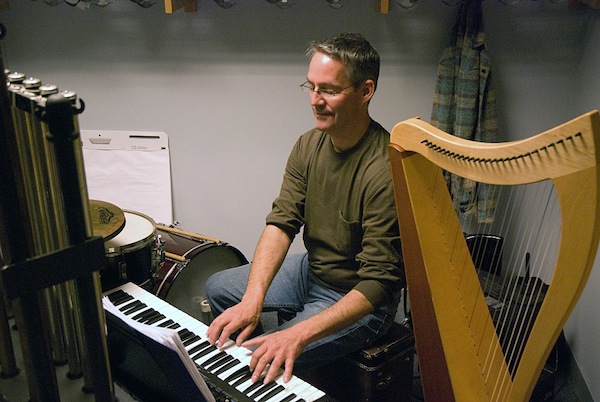
The anatomy of a sound cue
By Kira Obolensky, Ten Thousand Things
The innovative use of sound in Ten Thousand Things’ productions comes from the happy collaboration of necessity and imagination. Because Ten Thousand Things performs with the lights on, the ways in which light can be used to shape a play—to delineate time, to set place and scene, to bring attention, to calibrate mood—are replaced with sound. Sound signifies shifts in scene; it spotlights objects or information; it creates emotional color; it brings a diverse tapestry to every play Ten Thousand Things produces.
Peter Vitale , the theater’s very talented musical director, begins his process by creating a palette of instruments that reflect in some way the world of the play. For my play Dirt Sticks, the theater’s latest production, he wanted those sounds to be percussive, reflective of the play’s spoken narrative; and magical, even other worldy, to reflect the sense of wonder and magic that permeates the play. To that end, he began with a panoply of percussion instruments, xylophone, pitchpipes, windchimes, a and a violin tuned off key. Once such sound makers have been assembled, he and Michelle Hensley, the director, begin the painstaking process of honing in on what will eventually be a myriad of sound cues.
Vitale also functions as an inventor of sounds, using anything from an old window shade to a slate bar and resin mallet to find ways to underscore such moments in the play as enchanted shoes, penny rubs, and the arrival of a message-bearing pigeon. In Dirt Sticks, the character Henry Wand begins the play by trying to sell the audience a penny for a nickel. That penny is retrieved from a pocket and in actor H. Adam Harris’s hands it is practically invisible. Enter the sound cue—a high ding, timed to coincide with the actor’s presentational gesture. “Ding.” The penny becomes as visible as if a small spotlight were shining upon it.
The sound shows us the penny—it functions as a kind of spotlight. We hear each time the penny comes into play; the sound becomes a kind of signal for the event. Later, when Henry Wand rubs the penny to see his future, Vitale found himself needing a sound that would underscore the rubbing not only so that it could be “seen” but also to create a moment of expectation and drama. He found the sound by experimenting with a piece of slate that he scrapes with a hard, resin mallet for the penny rub. That same piece of slate is dragged along a large chime when the character of Laurel Fallows puts on a pair of enchanted, blue suede shoes. “These shoes make my feet feel light as a feather,” she says, and her legs seem to fly upward, operated by some invisible string. We hear the chime and slate combination and the moment becomes theatrical, important and mysterious.
Another moment in the play that asked for a complicated series of sound cues is the arrival of message-bearing pigeons. To create the right sound for beating wings of the bird, Peter discovered that a folded window shade that is shaken makes a frantic, initial flutter, followed by slower beats of the wings.
The pigeon’s message drop is underscored by a slide whistle. But it’s the actor who helps make the sound cue work: H. Adam Harris first looks for the pigeon cued by the beating wings, and then the drop of the message is completed as the actor runs to catch it.
Vitale talks about the collaboration between sound and actors as critical. He thinks of the sound as almost an audible puppet that needs to be manipulated by the performer in order to be made visible. “It’s not enough to just have the puppet operate smoothly, it also needs the actors to interact with it to give it meaning. It’s the same with sound,” he explains. To that end, Vitale and director Hensley always work with actors to find a way so that the cue comes with a specific consistent gesture.
During every performance, Peter sits at a corner of the playing area. While the action of the play will most likely keep your eyes focused on the actors, his performance at each venue is notable to watch as well. Script on a music stand, Peter navigates the live aspect of the performance (a dropped line, an audience interaction) with his own sense of how the sound shapes the audience’s experiences. Without his skills and interpretive talents at work, the show would most certainly be a lot quieter. But this soundscape also helps us understand important moments of information and transition–this is sound that, in fact, helps us see.
Recent Content
-
Artsarticle ·
-
Artsarticle ·
-
Artsarticle ·
